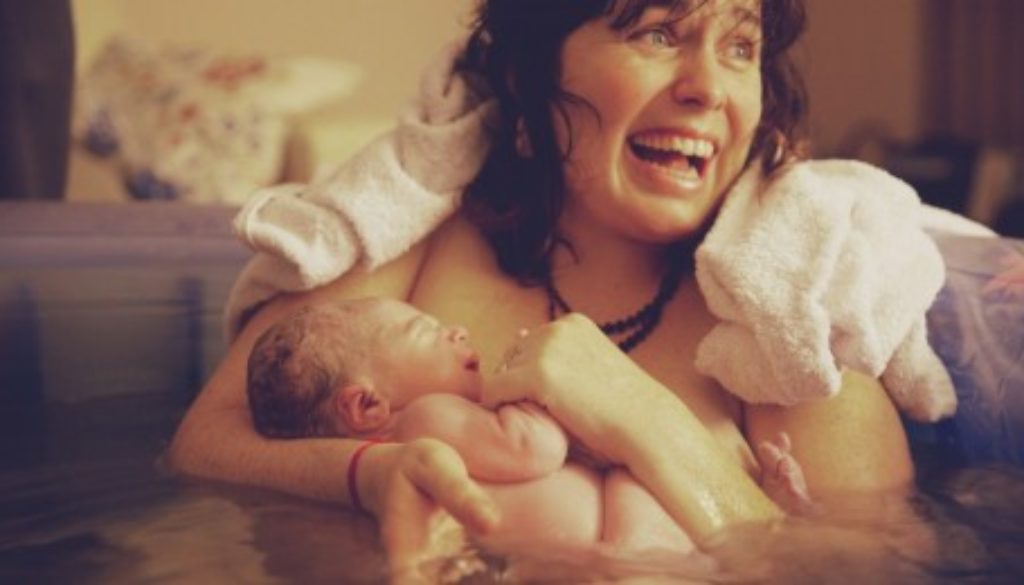Home Birth in the Time of Coronavirus
By Karin DeLucia, Midwife, and Kiersten Pilar Miller
As we have frequently said over the past few weeks, we are living in strange times. Many things we have taken for granted have been taken away from us, and many of our beliefs have been tested.
Home births are a choice we have always fully supported but have never proselytized the concept. We have always believed that the best place for a woman to give birth is where she feels the most comfortable and secure. For many women, that place is a hospital. There are many reasons behind this such as personal histories, social conditioning, media influence, family and community belief systems. But in the time of the Coronavirus the question that is of utmost importance is: “Where will she and her baby be most safe?”
In 2014 NICE (National Institue for health Care Excellence) came out with a study that stated that Midwife lead care is safer than hospital care and that women with low risk pregnancies were safer delivering at home or in a midwife care lead facility than a hospital.
In the time of the COVID-19 virus, these recommendations seem to take on even more importance. Hospital policies here in Italy are changing daily and whether a birth partner will be allowed in for the labour and delivery is up in the air.
 The truth is, we women have never stopped bringing our children into the world in the privacy of our own homes. Today our common belief system states that childbirth should take place in a hospital, viewing it as a dangerous event. In the past, a home birth was a normal, socially accepted event. Women passed on their concept of childbirth as a rite of passage that is a natural part of a woman’s life. Today we no longer have the intergenerational transmission of this knowledge as pregnant women enter into large healthcare structures with big bellies and come out with a baby. What happens in that time in between is the “unknown” and the few stories that are shared often pass on a culture of childbirth based on terror and pain. The result is that culturally, we have come to think that without “going somewhere” we are not able to give birth, and that a home birth is scary.
The truth is, we women have never stopped bringing our children into the world in the privacy of our own homes. Today our common belief system states that childbirth should take place in a hospital, viewing it as a dangerous event. In the past, a home birth was a normal, socially accepted event. Women passed on their concept of childbirth as a rite of passage that is a natural part of a woman’s life. Today we no longer have the intergenerational transmission of this knowledge as pregnant women enter into large healthcare structures with big bellies and come out with a baby. What happens in that time in between is the “unknown” and the few stories that are shared often pass on a culture of childbirth based on terror and pain. The result is that culturally, we have come to think that without “going somewhere” we are not able to give birth, and that a home birth is scary.
Home birth is common in many European countries and over the years it has become more and more recognized by Italian institutions. There are some regions in Italy that have regulated home birth and provide economic reimbursement for families who decide to deliver at home (See information at the end of the article).
“What if something happens?”
Culturally we are driven to think that childbirth is a matter of luck and not the result of a journey that lasts nine months.
In the nine months of pregnancy we can implement a lifestyle that helps us to maintain our health in the best way possible. During pregnancy our bodies tend to maintain a state of well-being with the obvious goal of preserving the continuation of the species (nature is intelligent). We can help encourage and promote this state of wellbeing by eating healthy foods, getting physical exercise, and making good lifestyle choices. Therefore, if the pregnancy follows a physiological path and there are many signs that the mother and child are both healthy, the possibility that an adverse event may occur during childbirth is significantly reduced.
“But what if something should happen?
Midwives who assist at home births are trained healthcare professionals, with experience, but above all, with the obligation to stay up to date on the management of emergencies during home births. When an emergency does occur, midwives carry with them the tools and pharmaceuticals to manage and stabilize the situation until an ambulance arrives. It must be said, however, that statistically non-urgent transfers occur more frequently than those of obstetric emergencies. When a delivery does depart from a normal physiological path, midwives have the time to recognize the situation, discuss it with the woman / family, before deciding to move to a hospital.
Already back in 1985 in Copenhagen the WHO (World Health Organization) stated:
“It is important to remember that it has never been scientifically proven that a hospital is a safer place than a home to give birth to a child if a woman has had a pregnancy without complications. Home delivery studies in developed countries have shown that morbidity and mortality rates for mother and child are equal to or less than the rates for births for uncomplicated pregnancies. These studies have revealed significantly lower interventions in home-delivery than in hospital deliveries (…) There are special cases where some women need specialized hospital care. Many women could have their children at home just with the same outcomes, if not better ones. “
“What are the benefits of a home birth?”
- Continuity of Care: this means your midwife will follow you during pregnancy, childbirth and the postpartum period.
- Personalized Care: this is a form of care that is tailored to you, based on your requests and your needs.
- Intimacy: the reduction of external interference in your most comfortable and relaxing environment; your home! There is no separation from your child from the moment of birth and your partner can be present and share all of this with you.
- Safety: two trained and equipped midwives who are focused only on you, instead of one midwife for numerous women in labour.
- Freedom: freedom of movement and expression, without judgment.
- Increase of positive health outcomes: the reduction of external interferences during delivery allows a very elaborate, but finely tuned system, to function to its full potential. Home births protect a woman from episiotomies and encourage the proper transmission of the microbiota from mother to child, establishing the foundation of both the short and long-term health of the baby.
- Delaying the cut of the umbilical cord for as long as possible: it allows for better neonatal outcomes compared to the premature cut (normally done before the delivering of the placenta) by giving him or her as much time as necessary to receive the remaining blood from the placenta, with its stem cells. This delay also allows a more gentle “switch over” from the intrauterine life to the extrauterine one.
- Satisfaction: women who give birth at home have a very high degree of satisfaction with their birth experiences..
- A respectful environment and bonding: respect is not only for the woman who is giving birth but also involves preparing a welcoming environment for the baby, a space that is warm, quiet, with low lighting and contact with mum and dad and siblings if present.
- Higher rates of successful breastfeeding: all of the conditions listed above lead to greater success in the initiation and establishment of breastfeeding. Because this too is not a matter of luck but is facilitated by good information and support during pregnancy, labor, delivery and especially the two hours after birth.
- And at this particular moment in time, avoiding healthcare structures that are dealing with an international health crisis. It means not adding to the burden our healthcare providers are shouldering and avoiding being exposed to the myriad of bacteria and viruses normally present in a hospital but of course, now COVID-19.
There are without a doubt medical procedures that save lives and that should be used in the few  cases in which they are warranted but when medical interventions are utilized during a physiological birth, a chain reactions begins, in which one procedure creates the need for another and another, until the body can no longer compensate autonomously and needs further external interventions. Therefore, home births reduce the risk of complications associated with sanctioned iatrogenisis (illness or damage caused by medical interventions).
cases in which they are warranted but when medical interventions are utilized during a physiological birth, a chain reactions begins, in which one procedure creates the need for another and another, until the body can no longer compensate autonomously and needs further external interventions. Therefore, home births reduce the risk of complications associated with sanctioned iatrogenisis (illness or damage caused by medical interventions).
In this time of uncertainty, home birth returns as a unique way to achieve the best possible birth outcomes for both mother and child.
“Childbirth is a physiological process that our body knows how to do perform. We are competent! We just have to discover our own personal way of doing it. “
Something to keep in mind at this time of an international healthcare crisis: The only healthy person in the world who checks into a hospital; is a pregnant woman. We wish all of you embarking upon the wonderful path of parenthood the best wishes wherever you decide to greet your little one. Welcome to the greatest adventure of your lives!
State of Home Birth in Italy:
The regions in Italy where the cost of Home Births are covered by the state are: Torino, Reggio Emilia, Modena e Parma.
The regions where the costs of Home Births are partially reimbursed by the state are: Piemonte, Emilia Romagna, Marche, provinces of Bolzano e Trento, Lazio. The reimbursements vary from €800 to €1500 (Emilia Romagna).
It will be interesting to see if this situation leads to a change in policy regarding the coverage of home births by the Italian state and other countries.

Karin DeLucia is a Midwife, who lived and worked in New Zealand for two years, expanding upon her English and her midwifery skills. She has an Italian Language website www.ostetricakarindelucia.

Kiersten Pilar Miller is a Mombassador and Bellies Abroad Founder. She has lived in Rome since 2004 and is a single mom to a precocious self proclaimed feminist tween.
Images thanks to Kevin liang, Homebirth Australia & Francesco Sili
